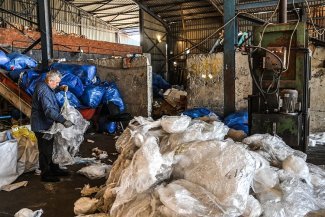One February evening, Samuel Mwangi watched as a swarm of desert locusts arrived and sat on the trees near his farm at Kariara village, in Kenya’s eastern Tharaka Nithi County. The next morning, they began destroying crops on his seven acres of land as he looked on helplessly from a distance, full of despair after several failed attempts to drive the locusts away.
“Here on my farm, they worked on my maize, coffee and beans as I have never seen before,” the 61-year-old father of eight tells Equal Times.
As a result of unusually hot weather and heavy rains caused by climate change, the largest swarm of giant locusts seen in almost three-quarters of a century are destroying crops across east Africa, central Asia and the Middle East, putting as many as 20 million people at risk of “ an unprecedented threat to food security and livelihoods at the beginning of the upcoming cropping season,” to the Food and Agriculture Organisation of the United Nations’ (FAO) Locust Watch online information hub.
In Kenya, which has been particularly badly hit, Mwangi is a full-time farmer. His life, and that of his whole family, is completely dependent on his crops as a source of food and income for his household needs and children’s school fees. In addition, he employs a number of labourers to work on his farm.
“Depending on the yields, sometimes I employ five or six people to help me pick coffee berries, and every other season I employ others to plant, weed and harvest the maize and beans,” Mwangi says.
The FAO estimates that agriculture is Africa’s biggest employer, with 54 per cent of the continent’s jobs, livelihoods and income coming from the sector. In Kenya, agriculture is thought to contribute to 26 per cent of the Gross Domestic Product (GDP) directly and another 27 per cent indirectly, while employing more than 40 per cent of the total population – some 19 million people.
But as the desert locusts continue to destroy crops, more lives and jobs in the agricultural sector hang in the balance.
Ever since swarms of locusts from Yemen invaded Ethiopia and Somalia in June 2019, “the most destructive migratory pest in the world” has swept through Eritrea, Djibouti, Kenya, South Sudan, Sudan and Uganda in Africa, even going as far as the Democratic Republic of Congo. According to the FAO, a single, 40-million-strong swarm covering one square kilometre can eat the same amount of food in one day as 35,000 people.
But with the world’s attention diverted towards combatting the coronavirus pandemic, the FAO is warning that the worst of the locust invasion may still be yet to come. As the mature desert locusts migrate throughout different countries, they lay eggs, some of which are now beginning to hatch. Although these wingless nymphs cannot fly, they are still able to destroy pastures and as they mature into winged adults and generate new swarms.
“Our current concern is the second generation of locusts,” says Hamisi Williams, assistant FAO representative to Kenya. “Because by the time they hatch, they will be twenty-fold the initial number of locusts, and it is anticipated that it will coincide with the initial phases of the planting season [in March/April]. The hoppers are voracious feeders, and we are concerned that they might wipe out the germinated crops.”
“There is going to be a crisis”
The Kenya Plantations and Agricultural Workers Union assistant secretary-general, Meshack Khisa, says the Kenyan government is mishandling the desert locust crisis as it has not moved quick enough to contain the spread of locusts by spraying the hoppers while they are unable to fly (and therefore easier to eradicate). He fears that the millions of Kenyans that depend on crops for food will face ruin if the locusts destroy their farms.
“Kenya’s economy is largely dependent on agriculture as the leading income earner followed by the manufacturing industry. You can imagine what will happen if the desert locusts invade a huge plantation – say, for example, tea, coffee or any other crops. It is going to cause a catastrophe because this sector employs a great number of people. These people will be jobless, and when they are jobless in large numbers, the likelihood for an economy to collapse is very high, as well as the likelihood of people lacking food,” Khisa warns.
“There is a ripple effect of people employed in the agricultural sector; they end up using their resources in the economy. So you find that the economy in these regions will be highly affected, and what will follow is that we are going to have a crisis,” he adds.
However, containing and controlling the desert locusts is a huge challenge for many countries in the region as funds and resources are not readily available. A US$10 million loan was approved in mid-March by the United Nations’ Central Emergency Response Fund (CERF) to help the FAO prevent the locust invasion from causing a humanitarian disaster, bringing the funding pledged to the FAO to tackle the crisis to US$110.5 million, although this falls short of the US$153.2 million funding target.
Hassan Charfi is the deputy director for agriculture in Marsabit County, which has recorded the largest number of swarms in Kenya. As the head of the Marsabit Desert Locust Control Base, he tells Equal Times that his county is already overwhelmed by the swarms, and with new swarms maturing and ready to lay eggs from the first week of April onwards, things are likely to get much worse.
“We have not controlled the mature locusts and we are not in any way likely even to control the nymphs. These will soon be aggregated, forming a band after which they be airborne. Then they will move, feast and roost. The destruction will be unthinkable,” Charfi warns.
Good news from Uganda
In Uganda, the Agriculture Ministry says that the country is likely to avoid the worst of the invasion because the harvest season for most major crops took place in December, leaving little for the locusts to feast on.
Charlotte Kemigyisha, a member of the Desert Locust Control Activities Team at the Ministry of Agriculture tells Equal Times: “Luckily for us, the invasion comes at a time when farmers have harvested crops, and as such there is hardly anything in the gardens. Our concern and efforts at the moment are geared towards preparation for the planting season that is around the corner and the conservation of crops.” Asked if there are likely to be job losses caused by the locusts in Uganda, Kemigyisha says no. “It is anticipated that the extension officers will work even harder with the farmers on smart post-harvest handling practices.”
She continues: “The Ministry of Agriculture, Animal Industry and Fisheries together with the Office of the Prime Minister will support the communities with planting materials, food and other necessary materials to cushion them from hunger and other adverse effects. Since the majority of the rural households are employed by farming, the government will support the communities with other income generating activities until such a time as when the region is considered free of the invasion. The situation will normalise in the short term,” Kemigyisha asserts.
But as for farmers elsewhere in east Africa, such as Mwangi, if the situation is not contained right away, his sole source of income is at huge risk of being destroyed. “If the government is not going to help us in driving the locusts and destroying their eggs from hatching, I will lose food and money and all those who depend on me for employment will not have an income to feed their families,” Mwangi observes.









